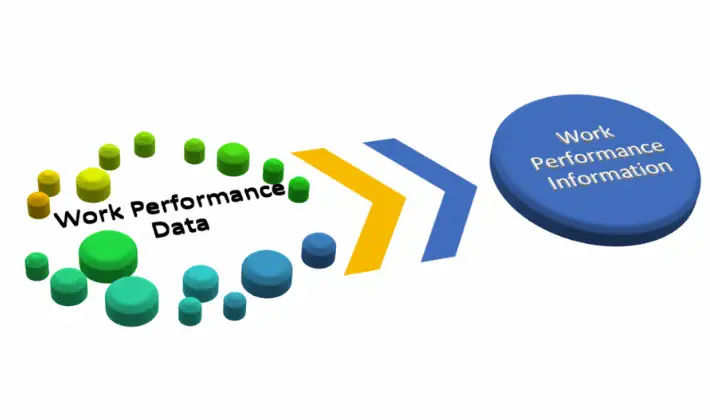You might be preparing for the PMP certification exam and want to know the difference between Work Performance Data and Work Performance Information.
Understandably so. There are many confusing terms defined in the PMBOK Guide. PMP students often get confused between such terms as the definitions are often very cryptic.
Work Performance Data and Work Performance Information are two such terms.
People who have Data Science or Information Technology background understand them easily. Data and Information are very common terms in these fields. But others, who have not studied these subjects, find it very difficult to distinguish between them.
Data and Information have specific meanings. The difference between these two terms can be easily understood by looking at the above image.
In very simple language, we can say that Computing Devices need Data whereas Humans need Information.
Let us define and differentiate between these terms in a scietific and logical manner.
Work Performance Data (WPD) And Work Performance Information (WPI)
Let us start by looking at English language meanings of these terms.
Data is raw, unorganized facts that need to be processed. Data can be something simple and seemingly random and useless until it is organized.

When data is processed, organized, structured or presented in a given context so as to make it useful, it is called information.

Meaning of WPD And WPI In Project Management
Data and Information used to be simple terms till PMI introduced them in the PMBOK Guide. Leaving the humor aside, let’s look at the history of these terms.
- Work Performance Data – This term was not part of PMBOK Guide 4th edition and was introduced in the 5th edition.
- Work Performance Information – This term was part of PMBOK Guide 4th edition but its meaning was changed in the 5th edition.
The concepts regarding Work Performance Data and Work Performance Information were present in PMBOK Guide 4th edition. However, PMI was not using standardized meaning & usage of Data and Information. This was changed with PMBOK Guide 5th edition and has continued forward. The following diagram explains the difference between WPD and WPI further.
Work Performance Data For PMP Students
The raw observations and measurements identified during activities performed to carry out the project work. Examples include reported percent of work physically completed, quality and technical performance measures, start and finish dates of scheduled activities, number of change requests, number of defects, actual costs, actual duration etc.
PMBOK Guide
In simple terms Work Performance Data can be considered as Project Status on a particular date (Control Date).
Work Performance Data is an output of PMBOK Guide Process 4.3 – Direct and Manage Project Work. It is an input to all Monitoring & Controlling (M&C) Processes except Integration Process 4.4 & 4.5 – Monitor and Control Project Work & Perform Integrated Change Control.
Let me give you few more examples of Work Performance Data. Each of the following examples are written with reference to different Knowledge Areas. In PMBOK Guide all Knowledge Areas have at least one M&C process. All these M&C processes take Work Performance Data as an input:
Scope – ‘D’ Deliverables have been completed
Time – ‘n’ Activities are started & ongoing, ‘m’ Activities have been completed
Cost – ‘M’ units of money have been spent
Quality – ‘X’ Requirements have been completed, ‘Y’ Change Requests have been completed
Communication – ‘C’ communication items have been sent
Risks – Scheduled Milestone ‘S’ is behind, ‘R’ units of money have been used as Contingency Reserves
Procurement – ‘I’ invoices have been processed and paid, ‘D’ Deliverables have been received from Contractor
Stakeholder – ‘P’ percentage of work has been completed
Work Performance Information For PMP Students
The performance data collected from various controlling processes, analyzed in context and integrated based on relationships across areas. Examples of performance information are status of deliverables, implementation status of change requests, and forecasted estimates to complete.
PMBOK Guide
In simple terms Work Performance Information can be considered as processed Work Performance Data.
Work Performance Information is an output of all Monitoring & Controlling (M&C) Processes except Integration Process 4.4 & 4.5 – Monitor and Control Project Work & Perform Integrated Change Control. Work Performance Information is an input to PMBOK Guide Process 4.4 – Monitor and Control Project Work.
Let me give you few more examples of Work Performance Information. Each of the following examples are written with reference to different Knowledge Areas. In PMBOK Guide all Knowledge Areas (with the exception of Human Resource Management) have at least one M&C process. All these M&C processes produce Work Performance Information as an output:
Scope – ‘D’ Deliverables have been accepted, R Deliverables have been rejected
Time – A Schedule Milestone is behind by ‘n’ days.
Cost – A Control Account is over-budget by ‘M’ units of money
Quality – ‘R’ requirements have been Inspected
Communication – ‘C’ communication items have been fulfilled
Risks – R’ Risks have occurred
Procurement – ‘C’ new Claims have been made by the Contractor
Stakeholder – ‘D’ Deliverables have been accepted
Final Thoughts
PMBOK Guide is a standard for Project Management. PMI has used universally accepted standard meanings of terms ‘Data’ and ‘Information’. This is a move towards right direction. However, I feel, there are many inconsistencies with the way these terms have been used in the PMBOK Guide.
- Work Performance Data is raw, unorganized and observed facts. It does not provide any intelligence.
- Work Performance Information is processed, organized and structured. It helps in decision making.
Over To You
What other terms do you find difficult to understand? Do you think PMBOK Guide terminology is confusing?
Please leave a comment.









Great post. Thank you for sharing.
gREAT
These terms were so confusing a lot!your paper help a lot to have a clear comprehension.
Hi ASSOGBA, Thanks for your kind words. Let me what else you would like to see on this blog.
BR, Praveen.
great explanation with examples.